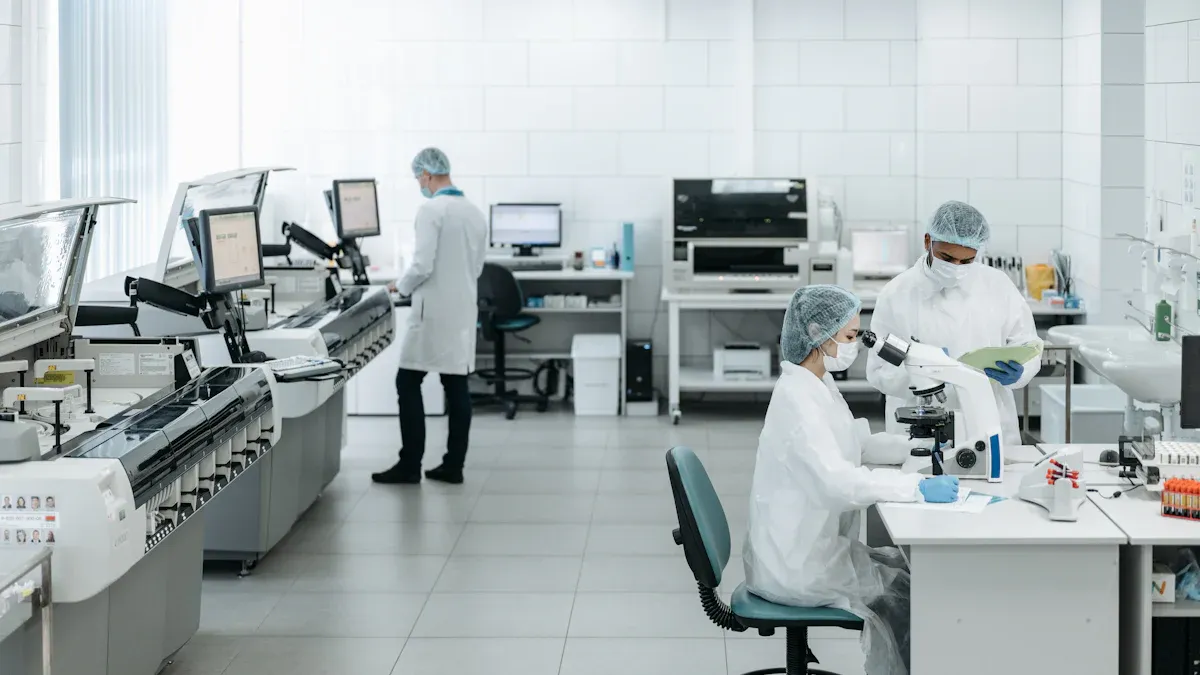What Makes the 1250T Die Casting Machine Ideal for Larger Projects

When tackling larger projects, you need a machine that delivers power, precision, and efficiency. The 1250T die casting machine stands out with its higher locking tonnage, enabling it to handle larger molds without compromising on quality. Its advanced production capabilities ensure faster cycle times and higher output. Features like automated systems and efficient cooling reduce downtime and boost productivity.
Metric | Description |
|---|---|
Machine Type | High-pressure die casting machines achieve faster cycle times and higher production rates. |
Automation | Automated systems reduce cycle times and human intervention, leading to higher production rates. |
Cooling Systems | Efficient cooling allows for faster solidification and quicker mold preparation, improving rates. |
Process Optimization | Fine-tuning parameters like injection speed and pressure maximizes production rates. |
This machine’s ability to optimize processes makes it a preferred choice for industries requiring large-scale or complex components.
Locking Tonnage and Its Role in Die Casting
What Is Locking Tonnage?
Locking tonnage refers to the clamping force a die casting machine applies to keep the mold securely closed during the injection process. When molten metal is injected into the mold at high pressure, the locking tonnage prevents the mold from opening or shifting. This ensures the final product maintains its shape and precision. Think of it as the machine’s grip strength, holding everything in place while the casting process occurs.
Why Higher Locking Tonnage Matters for Larger Projects
For larger projects, higher locking tonnage becomes essential. Larger molds require more force to stay closed due to the increased surface area exposed to injection pressure. Without sufficient locking tonnage, defects like flash (excess material leaking out of the mold) can occur. A machine like the 1250T die casting machine provides the necessary clamping force to handle these challenges. This ensures you achieve consistent quality, even with complex or oversized components.
1250T vs. 800T Die Casting Machines: Locking Tonnage Comparison
The 1250T die casting machine offers significantly higher locking tonnage compared to an 800T machine. While the 800T is suitable for medium-sized molds, it struggles with larger or more intricate designs. The 1250T’s superior clamping force allows you to work with larger molds and higher injection pressures without compromising on precision. This makes it the better choice for industries like automotive and aerospace, where large-scale components are common.
Production Capabilities of the 1250T Die Casting Machine

Output and Efficiency
The 1250T die casting machine delivers exceptional output and efficiency, making it a reliable choice for large-scale production. Its advanced design allows you to achieve faster cycle times, which means more parts can be produced in less time. This machine minimizes downtime with features like automated systems and optimized cooling processes. By reducing delays, you can maintain a steady workflow and meet tight deadlines.
Additionally, the machine ensures consistent quality across all components. Its precise control over injection speed and pressure helps you avoid defects, even when working with complex molds. This level of efficiency not only boosts productivity but also reduces waste, saving you time and resources.
Material and Mold Compatibility
The 1250T die casting machine supports a wide range of materials, including aluminum, magnesium, and zinc alloys. This versatility allows you to choose the best material for your project’s specific requirements. Whether you need lightweight components for the automotive industry or durable parts for heavy machinery, this machine can handle it.
Its compatibility with larger molds also sets it apart. You can work with intricate designs or oversized molds without worrying about performance issues. The machine’s robust clamping force ensures that the mold stays secure during the casting process, resulting in precise and high-quality components.
Cost and Energy Considerations
While the 1250T die casting machine offers high performance, it also helps you manage costs effectively. Its energy-efficient systems reduce power consumption, lowering operational expenses over time. Automated features further cut costs by minimizing the need for manual intervention.
Investing in this machine can lead to long-term savings. By producing more parts in less time and reducing material waste, you can optimize your production budget. For businesses focused on sustainability, the machine’s energy efficiency aligns with eco-friendly practices, making it a smart choice for modern manufacturing.
Applications of the 1250T Die Casting Machine

Industries That Benefit from the 1250T Machine
The 1250T die casting machine plays a vital role in several industries. Its ability to handle large molds and produce high-quality components makes it indispensable. Industries like automotive, aerospace, electronics, and consumer goods rely heavily on this machine.
Industry | Description |
|---|---|
Automotive | Produces parts for vehicles, enhancing performance and safety. |
Aerospace | Manufactures components for aircraft, ensuring precision and reliability. |
Electronics | Creates intricate parts for electronic devices, focusing on detail. |
Consumer Goods | Develops various products for everyday use, emphasizing versatility. |
In the automotive sector, this machine helps create lightweight yet durable parts, improving fuel efficiency and safety. Aerospace manufacturers depend on it for precision components that meet strict standards. Electronics companies use it to produce intricate parts for devices like smartphones and laptops. Even consumer goods benefit from its versatility, enabling the production of everyday items with consistent quality.
Types of Projects Best Suited for the 1250T Machine
You’ll find the 1250T die casting machine ideal for projects requiring large-scale production or complex designs. It excels in creating oversized components, such as engine blocks or structural parts for vehicles and aircraft. If your project involves intricate molds with fine details, this machine ensures precision and consistency.
High-volume production is another area where this machine shines. Its efficiency allows you to meet tight deadlines without sacrificing quality. Whether you’re manufacturing lightweight parts for the automotive industry or durable components for heavy machinery, this machine adapts to your needs.
Limitations and When to Use an 800T Machine
While the 1250T die casting machine offers impressive capabilities, it may not always be the best choice. For smaller or medium-sized molds, the 800T machine provides a more cost-effective solution. It consumes less energy and requires less space, making it suitable for projects with lower production demands.
If your project doesn’t involve high injection pressures or oversized molds, the 800T machine can handle the job efficiently. Choosing the right machine depends on your specific requirements, including mold size, production volume, and budget.
Key Advantages of the 1250T Die Casting Machine
Superior Performance for Large Molds
The 1250T die casting machine excels when working with large molds. Its clamping force of 1250 tons ensures the mold stays securely closed during the casting process. This high clamping force is essential for maintaining precision, especially with molds that have tight tolerances. You can rely on its advanced automation and control systems to deliver accurate results, even for complex shapes.
This machine also offers unmatched versatility. It can produce a wide range of metal parts, from large structural components to intricate designs. Whether you’re manufacturing parts for the automotive or aerospace industry, the 1250T die casting machine provides the performance you need to meet demanding project requirements.
Increased Production Efficiency
Efficiency is a hallmark of the 1250T die casting machine. Its advanced hydraulic systems enable faster cycle times, allowing you to produce more parts in less time. Automated features reduce the need for human intervention, minimizing downtime and ensuring continuous operation.
Optimized cooling systems further enhance efficiency by speeding up solidification and shortening cycle times. You can also fine-tune parameters like injection speed and pressure to improve fill times and part quality. These features work together to boost production rates while maintaining consistent quality, making this machine a valuable asset for large-scale manufacturing.
Versatility Across Industries
The 1250T die casting machine adapts to the needs of various industries. Its ability to produce both small, intricate components and larger, complex shapes makes it a versatile choice. Automotive manufacturers use it to create lightweight yet durable parts, while aerospace companies depend on it for precision components.
Electronics and consumer goods industries also benefit from its capabilities. Whether you’re producing intricate parts for devices or structural components for heavy machinery, this machine delivers consistent results. Its high clamping force and precision control ensure it meets the diverse demands of modern manufacturing.
The 1250T die casting machine offers unmatched performance for large-scale projects. Its clamping force of 1250 tons ensures precision and reliability, even with complex molds. You can rely on its advanced hydraulic system and temperature control to produce high-quality parts efficiently. Industries like automotive and aerospace benefit from its versatility and ability to handle demanding production needs.
Feature | Description |
|---|---|
Tonnage | Provides 1250 tons of clamping force for secure mold closure. |
Hydraulic System | Operates the clamping and injection units for high-pressure performance. |
Temperature Control | Prevents defects by ensuring proper solidification. |
Automation and Control | Delivers precise operation and monitoring for consistent results. |
This machine is a valuable investment for optimizing efficiency and meeting large-scale production demands.
FAQ
What makes the 1250T die casting machine better for large projects?
The 1250T machine offers higher clamping force, faster cycle times, and compatibility with larger molds. These features ensure precision and efficiency, making it ideal for large-scale production.
Can the 1250T machine handle different materials?
Yes, it supports materials like aluminum, magnesium, and zinc alloys. This versatility allows you to choose the best material for your project’s specific needs.
How does the 1250T machine improve production efficiency?
Its advanced automation, optimized cooling systems, and precise controls reduce downtime and defects. You can produce more parts in less time while maintaining consistent quality.
Tip: Fine-tune injection speed and pressure to maximize efficiency and minimize waste.
Is the 1250T machine energy-efficient?
Yes, it features energy-saving systems that lower power consumption. This helps reduce operational costs and aligns with eco-friendly manufacturing practices.
When should you choose the 800T machine instead?
The 800T machine works best for smaller molds or medium-scale projects. It consumes less energy and space, making it a cost-effective option for lower production demands.
Note: Always match the machine to your project’s size and complexity for optimal results.
See Also
Finding The Optimal Closing Force For Die Casting Products
A Comprehensive Guide To CAD Design In Die Casting
Exploring How CAE Analysis Enhances Die Casting Design
Defining Functional Testing In CNC And Die Casting
Enhancing Diecast Durability Through Electroplating Techniques
About Hunan Puka
Established in 2016 and based in Hunan, China, with a liaison point in Berlin, we are a Tier 2 supplier for the automobile industry. We specialize in the production of customized aluminum die-casting parts designed for machines with a closing force ranging from 280 to 1250 tons, with subsequent manufacturing process CNC machining and surface treatment. Our commitment to quality is reflected in our accredited quality management system, certified by ISO9001:2015 and IATF16949:2016 standards.


